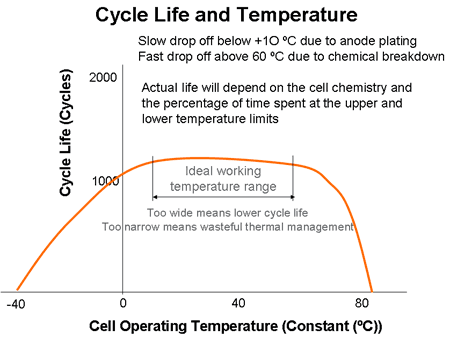My first post

Anyway,
battery is a chemical sandwich. Degradation happens because battery is not 100% stable and some processes are not reversible.
To stop degradation chemical processes must stop happening. At absolute zero degradation stops. But there is a critical
temperature where chemistry inside Li-ion cells will freeze. Let's assume that lowest healthy temperature is 1 temperature bar.
Chemistry inside cells is not frozen. Chemical processes happen but are very slow. This is why at some point charging speed
is limited and at another even acceleration is limited. This all boils down to voltage at every cell terminals: if chemistry is cold
adding charge results in voltage to rise to maximum (4.13V for Leaf) very rapidly because the "surface" of chemistry is saturated
with fresh juice but getting deeper takes a lot of time. Same with acceleration: pushing go pedal will result the whole pack to
suck juice at maximum speed. Surfaces of every cell are stressed with discharge. Voltage drops. To get the same power (80kW)
more amps must be pushed. But there is a limit. This is why acceleration will be limited at some point. This heavy pushing of
juice has some stress on the cells. Some of that pushing turns into defects. Eventually we call it degradation.
It is OK to charge/discharge at low temperatures but the rate of should be limited (unfortunately discharge is not).
At moderate temperatures chemical processes happen faster. Charging and discharging can happen faster as juice inside every
cell can move faster. Heavy discharging/charging is more healthy for the cell at appropriate temperatures because the whole cell
share the load more or less evenly. Unfortunately at moderate temperatures processes that are not needed also happen.
With higher and higher temperatures charging and discharging can happen faster and faster but vehicle can't use that
power anyway. Unfortunately unwanted processes happen more rapidly at that state without any advantages.
To sum up TEMPERATURE: the lower the temperature the slower the degradation. The lower the temperature the less capable
the battery is.
Defects also happen when juice is pumped in or out of the cell. This is hard to avoid. But what can be avoided are
the extremes: very full and very empty. Ideally cycles near 50% of charge are very easy to chemistry: there is a
good tendency for juice to complete the trip without defects to either side: cathode and anode (charging or discharging).
Also what can be avoided is pushing hard near the limits: rapid charging when very full (luckily Leaf has excellent
control over it as it never ever let any cell exceed maximum defined voltage) and rapid discharging while nearly empty.
Unfortunately Leaf has very bad control over that. Many users might have noticed that full power is available up
to the point when Leaf is almost dead. Then the Turtle appears. Power is heavily limited to very safe levels. I have analyzed
the situation and I can tell that when there is less than 10% of charge any heavy acceleration heavily pushes the whole
pack. Voltage is very unstable (the surfaces of cells are stressed). Some cells show more strength and some are weaker.
As I don't have a degree in chemistry I can not tell for sure is that harmful or not but I strongly suggest not to push Leaf
when low battery warning has appeared. For example Tesla's start to limit discharge rate much sooner than Leaf.
To sum up STATE OF CHARGE: using state of charge between 80% and 30% has acceptable effects on degradation.
The closer to extremes
multiplied with temperature the faster defects occur. It means that the worst thing to do is
to fully deplete the battery and keep it hot. The second worst thing is to fully charge the battery and keep it hot.
The speed of charging would be noticeable harmful if the voltage for any cell would get higher than magical 4.13V.
But it doesn't. So if we subtract degradation that happens with temperature and subtract degradation that happens
with maximum charge state 4.13V at recommended temperatures (which is not much really) there is hardly any more
defects that happen when rapid charging. Unfortunately really fast charging (30kW-50kW) only happens when cell is
not slow (not cold). This means ideal temperature or hotter. If it is ideal temperature it will soon be above that.
If it is above ideal temperature it will soon be way above ideal temperature. And this is why eventually heavy use of
Leaf's battery (taxi driving for example) with no way to cool chemistry faster will result in more degradation than on average.
It is true that charging up to 80% at moderate speed (up to 6,6kW for Leafs) does indeed have slightly less degradation
than rapid charging up to 80%. This is because the safe upper limit 4.13V is not reached even while charging (up to 1 hour).
The day when battery was manufactured does not have any direct relations with life left. At ideal storing conditions
battery that is a decade old can be in better shape than a battery that has been used for one summer.
As we mostly don't keep our vehicles is freezers degradation does happen. So the philosophy is simple:
use it but don't abuse it. Keeping car below 25C / 80F (24h average) and at 80% charge is reasonable for
excellent lifetime.
I tried to explain it as simply as possible. Also my native language is not English. This is why my style is weird :mrgreen:

